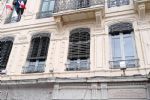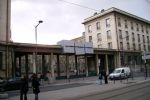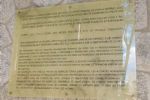Montluc Prison National Memorial
The Montluc prison, located at 4, rue Jeanne-Hachette in Lyon's 3rd arrondissement, is a military prison built in 1921 on the glacis of Fort Montluc. It is particularly famous for its role as a place of detention during the Second World War. More than 9,000 people, including Jean Moulin and Marc Bloch, passed through here between February 17, 1943 and August 24, 1944. After the armistice of June 22, 1940, the vote of full constituent powers to Philippe Pétain and the constitutional law of July 10, 1940, the Vichy regime was established, and Montluc became one of its prisons of repression. Placed in the free zone, Montluc remained a military prison, as an armistice army was maintained in this part of the country. The Lyon military court, which had a special section until November 1942, tried and imprisoned not only soldiers and draft dodgers, but also those who had joined the Resistance. Thanks to the new freedom-destroying laws, in addition to the many Communists, the first members of the Resistance were imprisoned, notably Gaullists, as well as members of thought groups banned by the Vichy regime. The prison gradually filled up, but conditions remained relatively acceptable. After the invasion of the free zone in November 1942, the Germans quickly seized the Montluc prison. After an initial requisition of around 30 cells in January 1943, the prison was finally fully requisitioned on February 17, 1943, and the French authorities evacuated. The prison then became a German military prison, progressively managed directly by Klaus Barbie. Thousands of men and women, hostages, racial persecutes and resistance fighters, were locked up there, for varying lengths of time, in inhuman living conditions, awaiting deportation or transfer. Originally comprising 122 individual cells, the prison gradually became overcrowded with the arrival of the Germans. Individual cells measuring 4 m2 held up to eight inmates, and it is estimated that between February 1943 and August 24, 1944, between 9,000 and 10,000 inmates passed through Montluc prison. Captain Seive was a prisoner there, and left an account published in 19455 as a testimonial. Jean Moulin and his companions were interned there after their arrest in Caluire-et-Cuire on June 21, 1943. On August 25, 1943, André Devigny was sentenced to death and managed to escape from prison6 ; this rare feat inspired Robert Bresson's film Un condamné à mort s'est échappé. On April 6, 1944, the Izieu children were taken to Montluc prison, before being deported to Drancy and then to the extermination camps. Between April 8 and August 21, 1944, 669 Montluc internees were executed at 33 different sites7 , including 21 at Dagneux in the Ain department on June 12, 19448 and 120 at the Côte-Lorette fort massacre in Saint-Genis-Laval on August 20, 1944. From August 17 to 21, 1944, 109 Resistance fighters and Jews were evacuated from Montluc prison on the orders of Klaus Barbie. They were massacred on the Bron airfield on August 17, 18 and 21, 1944. Montluc prison was liberated on August 24, 1944, thanks in particular to the efforts of Yves Farge. Source Wikipedia Photo credit Lucie, administrator of the "Seconde Guerre mondiale" group.










